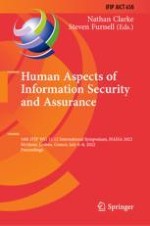2022 | Buch
Human Aspects of Information Security and Assurance
16th IFIP WG 11.12 International Symposium, HAISA 2022, Mytilene, Lesbos, Greece, July 6–8, 2022, Proceedings
herausgegeben von: Nathan Clarke, Steven Furnell
Verlag: Springer International Publishing
Buchreihe : IFIP Advances in Information and Communication Technology
